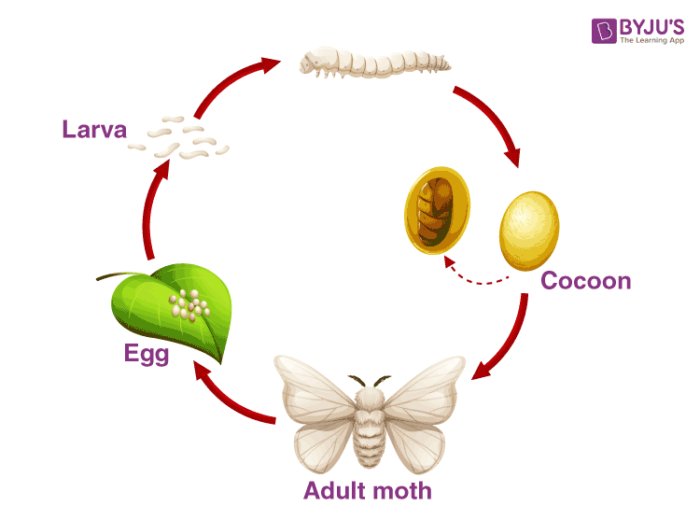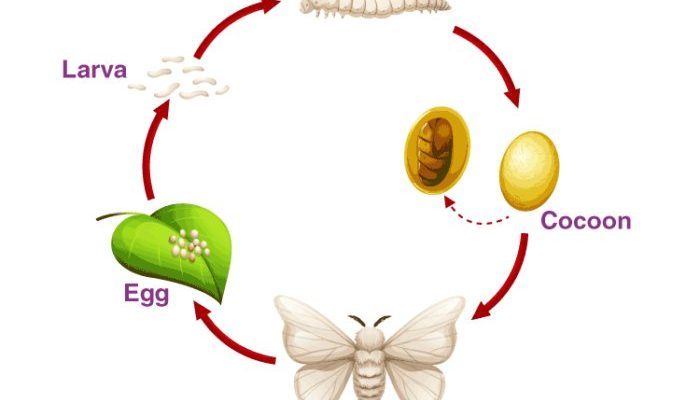
Silkworms are not just ordinary insects; they’ve been domesticated for thousands of years, primarily for their silk. So, if you’re curious about how these little guys grow up and ultimately produce such luxurious silk, you’re in for a treat! Let’s peel back the layers of this lifecycle and explore each intriguing stage.
The Beginning: From Egg to Larva
The silkworm lifecycle kicks off with the **egg stage**. A female moth lays hundreds of tiny, pale eggs—about the size of a pinhead! These eggs are usually laid on mulberry leaves, which are the primary food source for silkworm larvae once they hatch. It’s fascinating to note that the life of a silkworm begins in such humble circumstances; a single female can lay up to 500 eggs at a time!
After a week or so, the tiny larvae, also known as **caterpillars**, emerge from the eggs. They’re incredibly hungry right from the get-go. This stage is often referred to as the **larval stage**, and it’s here that the silkworm really starts to transform. The caterpillars begin munching on the mulberry leaves like they’re at an all-you-can-eat buffet. Honestly, they can eat a staggering amount of leaves—about 100 times their body weight in just a few weeks!
As they feed, the larvae will shed their skin multiple times—a process known as molting. This is necessary because they outgrow their old skin and need to make way for their rapidly growing bodies. It’s kind of like buying new clothes when you hit a growth spurt!
The Transformation: Pupa Stage
After about 4 to 6 weeks of chowing down, the silkworms reach their final larval stage. At this point, they’re ready for the next phase: becoming a **pupa**. This is where things get really interesting. The larva will stop eating and start looking for a safe place to spin its cocoon. In nature, this might be a cozy spot on a branch or leaf.
Once settled, the silkworm begins to spin silk around itself, creating a protective cocoon. This is a key moment because the silk produced is what we harvest for textiles. The spinning process can take anywhere from a few hours to several days, and the result is a beautiful, lustrous cocoon made up of long silk fibers.
You might be wondering how this silk is made. Well, the silkworm produces a protein-rich fluid from specialized glands which hardens when it comes into contact with air. This silk thread can measure up to 1,000 meters long, allowing for a continuous strand that can be unwound later. Once the cocoon is complete, the silkworm enters the pupa stage, where it is safely tucked away, preparing for its eventual emergence as a moth.
After a few weeks spent in its silky sanctuary, the time finally comes for the pupa to become a moth. This process is called **emergence**. The pupa gradually undergoes changes within the cocoon, developing wings, antennae, and the rest of its body. When it’s ready, the moth breaks free from its cocoon—what a dramatic moment!
Interestingly, silkworm moths are a bit different from many other moths. They don’t fly very well due to their larger bodies and heavier silk-covered wings. Once they emerge, their primary goal is to mate and continue the lifecycle. The male moth seeks out the females, and after mating, the cycle starts once again with the laying of eggs.
This stage is remarkable not only because it brings the lifecycle full circle but also because it highlights the intricate beauty of nature’s designs. It reminds us of the delicate balance in ecosystems where each stage serves a purpose.
The Role of Silkworms in Agriculture
Now, you might be wondering why silkworms are so important. Beyond their mesmerizing lifecycle, they play a crucial role in agriculture and the textile industry. The silk produced has been a valuable commodity for centuries, cherished for its softness and strength. The process of harvesting silk, known as sericulture, involves carefully collecting the cocoons while ensuring the pupa doesn’t emerge.
In many cultures, especially in Asia, silkworms have a significant economic impact. Farmers rely on silkworms for income, and traditional techniques have been passed down through generations. It’s amazing to think that a lifecycle that starts so small can contribute to industries worth billions of dollars!
Let’s not forget the environmental aspects either. Silkworm farming is relatively eco-friendly compared to synthetic fiber production. Plus, the byproducts of the silkworm lifecycle can be beneficial as well, such as using the waste from the leaves for compost or fertilizers.
Challenges and Conservation
Despite their importance, silkworms face challenges today. Modern farming practices and climate change are affecting their habitats and food sources. As demand for silk continues, there’s a growing need for sustainable practices in sericulture to ensure these fascinating creatures can thrive.
Conservation efforts aim to protect silkworm species and their environments. Additionally, educating farmers about sustainable practices can help mitigate negative impacts. Supporting local sericulture can also make a difference, ensuring that the lifecycle of silkworms goes on for generations to come.
It’s essential to look after the ecosystems that support silkworms. After all, the beauty of their lifecycle is intertwined with the health of our planet.
As we’ve explored the **silkworm lifecycle** from egg to moth, it’s clear that this journey is filled with wonder and intricacy. Each stage offers a specific role that contributes to the remarkable transformation and reminds us of the beauty in nature’s cycles. From the tiny egg to the elegant moth, every moment is intertwined with purpose and connection.
Next time you admire a silk garment or think about the role of insects in our world, remember the silkworm. Their lifecycle not only provides us with luxury textiles but also teaches us important lessons about sustainability and respect for nature. Let’s celebrate these little creatures and the magic they create!

